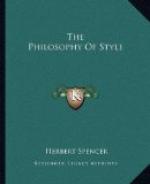45. Passing over much that may be said of like purport upon Hyperbole, Personification, Apostrophe, &c., let us close our remarks upon construction by a typical example. The general principle which has been enunciated is, that other things equal, the force of all verbal forms and arrangements is great, in proportion as the time and mental effort they demand from the recipient is small. The corollaries from this general principle have been severally illustrated; and it has been shown that the relative goodness of any two modes of expressing an idea, may be determined by observing which requires the shortest process of thought for its comprehension. But though conformity in particular points has been exemplified, no cases of complete conformity have yet been quoted. It is indeed difficult to find them; for the English idiom does not commonly permit the order which theory dictates. A few, however, occur in Ossian. Here is one:—“As autumn’s dark storms pour from two echoing hills, so towards each other approached the heroes. As two dark streams from high rocks meet and mix, and roar on the plain: loud, rough, and dark in battle meet Lochlin and Inisfail. . .As the troubled noise of the ocean when roll the waves on high; as the last peal of the thunder of heaven; such is noise of the battle.”
46. Except in the position of the verb in the first two similes, the theoretically best arrangement is fully carried out in each of these sentences. The simile comes before the qualified image, the adjectives before the substantives, the predicate and copula before the subject, and their respective complements before them. That the passage is open to the charge of being bombastic proves nothing; or rather, proves our case. For what is bombast but a force of expression too great for the magnitude of the ideas embodied? All that may rightly be inferred is, that only in very rare cases, and then only to produce a climax, should all the conditions of effective expression be fulfilled.
v. Suggestion as a Means of Economy.
47. Passing on to a more complex application of the doctrine with which we set out, it must now be remarked, that not only in the structure of sentences, and the use of figures of speech, may economy of the recipient’s mental energy be assigned as the cause of force; but that in the choice and arrangement of the minor images, out of which some large thought is to be built up, we may trace the same condition to effect. To select from the sentiment, scene, or event described those typical elements which carry many others along with them; and so, by saying a few things but suggesting
many, to abridge the description; is the secret of producing a vivid impression. An extract from Tennyson’s ‘Mariana’ will well illustrate this:
“All day within the
dreamy house,
The door upon the hinges
creaked,
The blue fly sung i’
the pane; the mouse
Behind the mouldering
wainscot shrieked,
Or from the crevice
peered about.”




